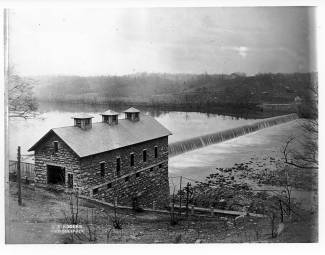Collection Name
About
This dam, like all six of the dams built by the C&O Canal Company, was originally built of wooden cribs filled with stones and covered with heavy planks. Because such bridges were very vulnerable to damage by floods and winter ice, in the 1850s the company replaced the original crib dam with a solid masonry dam that was considered one of the strongest in the county when completed. The inlet or guard lock associated with this dam is a mile upstream. A high guardwall to protect the canal, extends from the high abutment at the end of the dam to the nearby hillside and a stop gate was built in the guard wall for the canal to pass through it. The winch house that held equipment and planks used to close the stop gate when necessary to protect the canal below, is visible at the extreme right of the picture. From the dam abutment on the Maryland side there is also a guard wall running along the river to the inlet lock upstream. It protects the towpath and canal below it. Today the C&O Canal “towpath” between the dam and inlet lock is on top of the guard wall and part of the historic towpath down beside the canal is not maintained and is therefore so heavily overgrown as to be impassable.
The power plant on the West Virginia side was built in 1910 and listed on the National Register of Historic Places in 1978.
84.4 Mile
NPS File 1011
A total of seven dams were constructed or rebuilt by the Chesapeake & Ohio Canal Company between 1828 and 1850. The purpose of the dams was to create a slack area in the river that could feed river water through inlet locks and into the canal bed. When canal water levels would fall making it difficult if not impossible for boat travel from Cumberland to Georgetown, the guard lock paddle gates would be opened in order to raise the water levels. Conversely, the guard lock served as a barrier between the frequent flood waters of the Potomac and the canal in order to protect the massive construction and engineering feat that is the C&O Canal.
